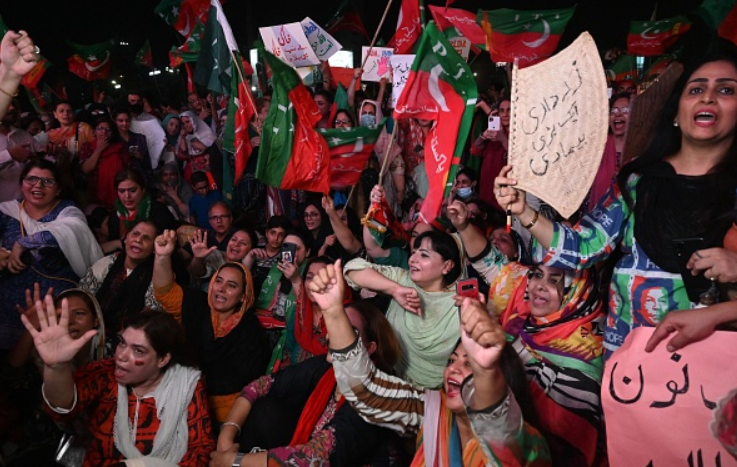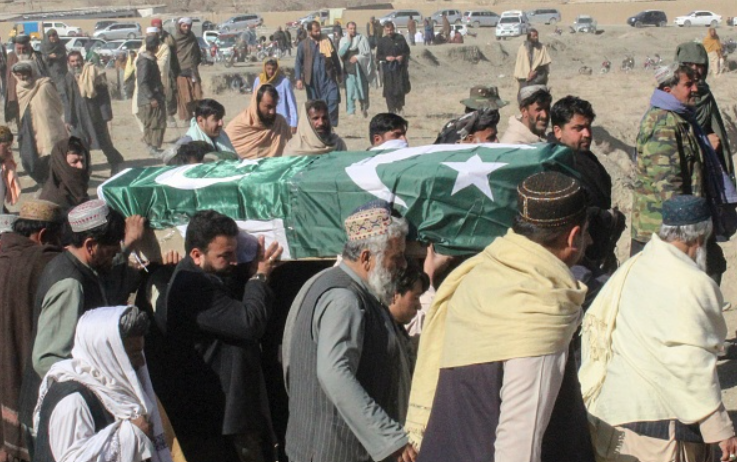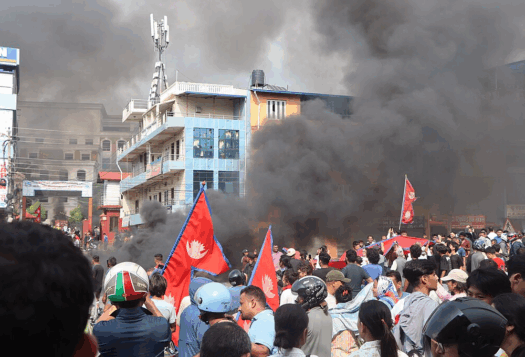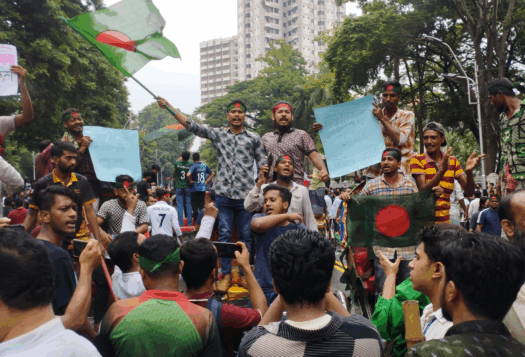
For Pakistan, 2022 began on a high note with the launch of its first citizen-centric National Security Policy (NSP), which reiterated the need to put human security at the center of the country’s security apparatus. Under this new approach, Pakistan would diversify its foreign policy partners with a particular focus on economic diplomacy. However, the year’s events proved challenging in achieving Islamabad’s strategic vision, and optimism dissipated as political instability and concerns of financial default loomed large.
At its 75th anniversary, the state of affairs in Pakistan seems to resemble how it was on its first. The country experienced rapid changes in government and subsequent political chaos. Its foreign policy was caught between opposing geopolitical blocs after former Prime Minister Imran Khan’s visited Russia during the Ukraine invasion. The current account deficit spurred a financial crisis and was further burdened by the devastation from unprecedented floods. Although it began with hope, last year proved turbulent.
Khan’s Exit, a New Coalition Government, and Power Plays
The exit of former Prime Minister Imran Khan through a vote of no-confidence (VNC) in April initiated a saga of volatility in Pakistan’s domestic politics.
On March 8, Pakistan Tehreek-e-Insaf’s (PTI) opposition parties, including Pakistan People’s Party (PPP) and Pakistan Muslim League-Nawaz (PML-N), initiated a motion of no-confidence against then-sitting Prime Minister Imran Khan, citing mismanagement of the economy and rising inflation. While PTI continued to facilitate backchannels to keep their coalition government intact before the VNC, it accused opposition leaders of influencing its party workers through unfair means after a video went viral showing 24 PTI members sitting in the house of the an opposition party member. What became clear was that Khan had lost support from within the coalition and the establishment.
The year’s events proved challenging in achieving Islamabad’s strategic vision, and optimism dissipated as political instability and concerns of financial default loomed large.
The following months demonstrated the influence of the political establishment in steering the country into instability for its own political interests. Instead of hosting the VNC, the deputy speaker of the National Assembly surprisingly ruled it out, terming it unconstitutional. Minutes later, the President dissolved the National Assembly and PTI issued the call for early elections. However, five days later, the Supreme Court restored the Assembly. In an unprecedented manner, the Supreme Court and Islamabad High Court opened at close to midnight to pass an order to initiate the voting process. Before that could proceed, the VNC was put into motion, leading to the appointment of a new Prime Minister.
Khan immediately attributed his historic fall from power in April to his party’s practice of an independent foreign policy. According to PTI, Khan’s visit to Russia—the first visit by a Pakistani premier to Moscow in 23 years—was looked on unfavorably by the West and therefore led to his expulsion. However, most recently, PTI has refrained from reiterating this attribution due to Khan’s desire to rebuild good relations across the globe, including with the United States.
While Khan was removed from federal office, his party holds government in Punjab—the largest province in terms of population and traditionally a foothold of PML-N—and in Khyber Pakhtunkhwa (KPK). To galvanize support for the incoming election, PTI and the coalition government have regularly hurled criticism at each other, predominantly on accounts of corruption.
Between April and November, the Khan-led PTI mobilized its base to support haqiqi azadi (true independence) and early elections, evident from PTI’s electoral victories in the by-elections. This level of polarization in Pakistani society is unprecedented, especially concerning the role of the military in the country’s politics. In the PTI’s long march from Lahore to Islamabad, political tensions took a drastic turn when Khan was shot in Wazirabad. Despite the risks, Khan was back at the Rawalpindi rally after three weeks with a new ultimatum: to dissolve Punjab and KPK assemblies if early elections are not called.
Appointment of a New COAS
Another significant development this year was the appointment of the new Chief of Army Staff (COAS) General Asim Munir. Along with improving public opinion of the military, the COAS faces escalating security threats from Tehreek-e-Taliban Pakistan and other terrorist groups operating in Afghanistan.
The appointment of General Munir is expected to amend strained civil-military ties and rebuild the military’s image. While Khan has said the PTI will dissolve its assemblies if early elections are not held, its decision to follow through depends on PTI’s relations with the country’s powerful military. Two days after then-PM Khan faced the VNC, the Inter-Services Public Relations (ISPR) Director General said the military has no role in the country’s political affairs. However, some analysts speculate that the military severely influenced the political equation, supporting Khan’s ousting. Additionally, most of the public remains unconvinced by the military’s efforts to maintain neutrality. General Munir’s appointment on the principle of seniority contrary to the previous pattern of instituting the incumbent government’s preference for their favored candidate has likely set a new precedent in civil-military relations. The COAS has also appointed a new ISPR-DG two days after taking charge, indicating his priority to rebuild the army’s public perception.

Another critical element for the COAS is curbing the resurgence of the TTP. Unilaterally ending the ceasefire signed with the government in June, the TTP has warned of attacks across the country and carried through with these threats. The COAS approved an operation launched in the Bannu district to clear TPP operations and signal potential counterterrorism cooperation with the United States. While the recent attack on Pakistan’s Kabul mission was attributed to ISKP, these two events are not isolated. The continuing challenge for COAS is to choke the reemerging terrorist threats within Pakistan.
Narrow Escape from Financial Crisis
As soon as the new coalition government came into power, it needed to stabilize the economy. For almost half the year, the coalition government continued to dodge the risk of a fiscal default. In July 2022, foreign currency reserves reportedly fell to USD $9.7 billion, leaving the government on the verge of economic default without support from the International Monetary Fund (IMF).
The coalition government had to inevitably pursue a revival of the IMF program to resolve the financial crisis. While Pakistan entered the IMF program in 2019 with the agreement of $6 billion over 39 months, Islamabad has received only half of the funds so far. This stems from the former Khan-led government’s history of failing to keep up with program targets and delivering on core conditions— though his was not the first government to have such a track record. For instance, the IMF approved a $1 billion disbursement for Pakistan in February last year. During the same month, former Prime Minister Khan announced a fuel price cap as part of relief measures for the public, backtracking on the program targets.
Pakistan narrowly escaped financial default by implementing tough decisions such as removing price caps. While inflation increased to 14 percent—breaking a seventy-year record—the $1 billion bailout in August was successful in fending off the immediate risks of default. However, Pakistan is not out of the woods just yet; amidst such financial uncertainty, one thing that remains clear: inflation will only increase in 2023, reducing the chance of relief for citizens.
Monsoon Madness: Devastating Floods
Pakistan’s already-fragile economy was severely hit by the devastation from unprecedented flooding in July and August. According to the World Bank, the infrastructural damage caused by the floods and the resulting loss in revenue amounted to $30 billion. Furthermore, 45 percent of Pakistan’s cropland was submerged under rainwater. The damage was not only limited to economic ramifications but also extended to loss of lives and mass displacement. This year, monsoon rainfall poured with a volume four times greater than in previous years. Notably, it rained excessively in Sindh and Balochistan, provinces that hardly experience monsoon rainfall and thus lack the infrastructure to adequately deal with floods of this proportion.
Along with emerging terrorist attacks, climate change poses immediate security threats to the country and can no longer be overlooked.
The devastation caused by the floods further highlighted Pakistan’s vulnerability to climate change. While leadership has acknowledged the risks of climate change, as seen in the NSP, there seems to be limited agreement on the extent and scale it poses, especially compared to traditional security threats. Islamabad, as usual, only acknowledged the intensity of the crisis when sufficient damage was done.
Managing Turbulence Ahead
The current year will inherit much of the political turbulence and economic instability that characterized 2022. While Khan has issued an ultimatum, this might be his last negotiating tactic to pressure the government to hold early elections, given that his incendiary rhetoric against the military has alienated him from a traditional power center. However, with the unlikelihood of this possibility, political instability will follow in the months ahead.
Besides politics, Pakistan needs to reassess its economic model for long-term stability. Export-driven growth must replace dependence on financial institutions. For this, Pakistan’s economic outlook should expand to non-traditional areas such as technology. Along with emerging terrorist attacks, climate change poses immediate security threats to the country which can no longer be overlooked. While the government pursues climate preparedness internally, it should work towards regional cooperation frameworks as well. Last year reflected the resilience of Pakistan and its people to sustain and thrive. Unfortunately, conditions appear similar in the year ahead.
***
Click here to read this article in Urdu.
Image 1: Arif Ali/AFP via Getty
Images Image 2: Abdul Basit/AFP via Getty Images


